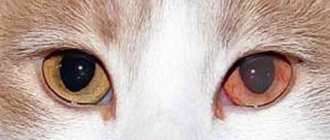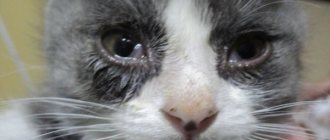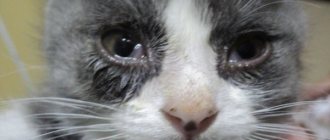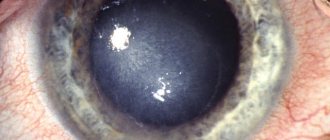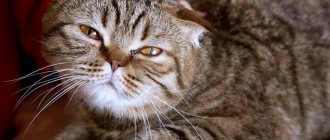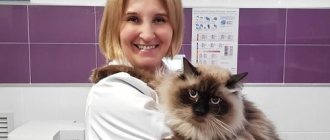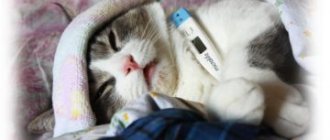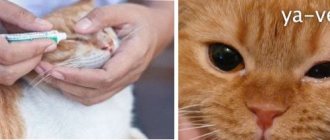The owner must carefully look after the pet, and if the cat’s one eye is watering and she squints, then he must carefully examine the pet and realize what is the reason for a similar situation. We'll tell you why a cat's eye is watering and what can be done.
Why doesn't a cat open one eye?
A constantly squinted or completely closed visual organ is a consequence of a pathological process in the body. All ophthalmological diseases in pets are divided into 3 groups:
- eye diseases;
- pathologies that arose against the background of other disorders;
- traumatic diseases.
If a cat’s eyes cannot open, the most common causes are the following pathologies:
- Keratitis, or inflammation of the cornea. Damage occurs due to injury, entry of a foreign body or chemical substance, or infection. Sometimes keratitis occurs against the background of helminthic infestation. It is accompanied by photophobia, lacrimation, discharge of pus, and redness of the corners of the eyes. Due to severe pain, the animal behaves restlessly and refuses to eat and drink.
- Conjunctivitis, or inflammation of the mucous membrane. The disease develops due to bacteria, viruses, and fungi entering the body. Inflammation of the conjunctiva may be one of the manifestations of allergies (to pollen or dust). Symptoms of the pathology include increased lacrimation, redness and swelling of the eyes, and discharge of pus.
- Glaucoma. Intracranial pressure increases due to injury or systemic disease. The outflow of intraocular fluid is disrupted. This leads to an enlargement of the eyeball, decreased visual acuity, and clouding of the pupil. At first, the cat or cat squints because it feels discomfort. In later stages, blindness is possible.
- Blepharitis, or inflammation of the edge of the eyelid. The disease occurs against the background of injury, infection, vitamin deficiency, parasite infection, burn (thermal or chemical). With blepharitis, the eyelids become red and thickened. The purulent scales that appear at the base of the eyelashes fall off and leave behind ulcers. The animal is in pain and constantly squints.
- Corneal erosion. The causes of its appearance are injuries, burns, viral, bacterial and fungal infections. The pet squints and scratches its eye with its paw, and behaves restlessly. Orientation in space is disrupted. If erosion is left untreated for a long time, a corneal ulcer may appear.
- Epiphora, or excessive tear production. Outwardly, the disease looks as if the animal is crying all the time. This leads to partial or complete blockage of the nasolacrimal duct. Epiphora can be congenital or acquired. An advanced form of pathology leads to the appearance of dermatitis.
A cat or cat may squint the visual organ due to mechanical injuries to the cornea. Most often this happens to pets that have free access to the street. Eye injuries received during fights or games with other animals often lead to inflammatory processes.
Glaucoma
Glaucoma
Elderly pets suffer from numerous chronic diseases, against the background of which eye pathologies develop. With glaucoma, intraocular pressure increases. The affected organ becomes sensitive to the slightest irritation. The cat develops photophobia: bright light causes the affected eye to squint.
Congenital glaucoma is observed in Persian, Siamese and British kittens. The development of the pathological process can be slowed down if the underlying disease is treated. Full recovery is impossible. Conservative treatment is aimed at relieving pain. If pathological signs increase, surgery is performed. Most often, the damaged organ is removed.
Glaucoma in a kitten
Prevention of congenital diseases involves excluding parents of sick kittens from breeding. Thoroughbred young animals should be purchased from trusted breeders who value their reputation.
Chronic diseases of older animals are prevented by compliance with housing and feeding standards, timely deworming and treatment against external parasites.
Diagnosis of the disease
If your pet constantly closes its eye, a veterinarian will find out the reasons. If alarming symptoms are detected, it is necessary to take the cat to the clinic.
Diagnostics includes procedures such as:
- visual acuity test;
- assessment of the general condition of the body;
- examination of the visual organs for damage;
- comparison of symmetrical features (size and shape of pupils, eyelids, eyeballs and slits);
- Ultrasound of the affected area;
- staining test;
- CT or MRI of the brain;
- X-ray of the skull.
Ophthalmological pathology may be a consequence of traumatic brain injury. Therefore, the examination must be comprehensive.
It is recommended to donate blood, urine and feces for analysis. Problems with the eyes can be caused by pathologies of internal organs or parasitic diseases.
Symptoms
Clinically, a corneal burn always manifests itself clearly and unambiguously: even without special knowledge, it is difficult to mistake it for another injury. The most striking symptoms of chemical and thermal burns are:
- acute, almost unbearable pain localized in the damaged eye and eyelid;
- reflex closure of the eyelids, photophobia;
- intense lacrimation (if the tear ducts are damaged, the sign may be absent);
- hyperemia of the skin, mucous membranes, conjunctiva;
- clouding of the cornea (noticeable with a severe burn).
Radiation damage may not be accompanied by unpleasant symptoms immediately after receiving it. Burning sensation, lacrimation, photophobia, hyperemia and photophobia appear after a few hours.
Methods for treating eye diseases in cats
If your cat squints or squints, it needs to be seen by a veterinarian. The specialist will find out the cause of this phenomenon and prescribe treatment.
However, not everyone has the opportunity to immediately take their pet to the clinic. In this case, it is recommended to examine the animal at home and provide first aid.
To do this you need:
- check whether a foreign body has entered the eye;
- rinse the damaged visual organ with saline solution or warm boiled water;
- Carefully remove the pus, moving from the outer corner of the eye to the inner.
Without the doctor's permission, it is prohibited to use antiseptic solutions or antibiotics for rinsing and treatment. Medicines, eye drops and ointments are prescribed only by a veterinarian after diagnosis.
Severe cases require surgery and suturing. This treatment is carried out in a hospital setting.
Spikes
The nictitating membrane, along with the upper and lower eyelids, is covered with a mucous membrane, so it is also susceptible to various inflammations.
During the acute stage of infectious rhinotracheitis in cats, necrosis of the epithelial tissue of the cornea and mucous membrane is observed. In this regard, the risk of formation of adhesions on the nictitating membrane increases significantly.
In severe cases of infectious rhinotracheitis, the animal requires intensive treatment with antiviral drugs and regular hygiene of the conjunctival sac. This will avoid the occurrence of adhesions.
If your cat has already formed adhesions, she will most likely undergo surgical separation. However, such an operation may not be effective for persistent adhesions, since they usually form again.
Surgical intervention is most successful for adhesions that occupy a small area.
If already formed adhesions are left untreated throughout the cat’s life, the tear drainage system and eyelid mobility will be impaired, and visual acuity will decrease.
Measures to prevent eye diseases
It is easier to prevent an ophthalmic disease in an animal than to treat it. Prevention includes:
- regular vaccination;
- preventing pet hypothermia;
- examination of the animal’s visual organs after street walks;
- washing the mucous membrane and eyelids with saline solution if wounds are found on them;
- timely contact a veterinarian.
A cat squinting its eye is not necessarily due to illness. Sometimes this is a variant of the norm, for example, when the animal is sleepy or calm. It is necessary to seek veterinary help if this symptom persists for a long time and is accompanied by lacrimation, pus discharge and deterioration in the pet’s physical condition.
Eye diseases in animals. Treatment of eye diseases at the IVC MBA.
All information posted on the site is provided in accordance with the User Agreement and is not a direct instruction to action. We strongly recommend that before using any product, you must obtain a face-to-face consultation at an accredited veterinary clinic.
Inflammation of the third eyelid
The nictitating membrane in an active cat is invisible. The transparent membrane protects the eye sphere from dust particles and debris. Due to the inflammatory process, the membrane hypertrophies and no longer fits under the eyelids.
Most often, unilateral inflammation is observed due to the following reasons:
- infectious diseases;
- allergic reactions;
- injuries;
- internal non-communicable diseases;
- congenital predisposition.
Most often, Persians, Britons, as well as mixed breeds and cats of related breeds get sick. Treatment is surgery. To prevent inflammation of the eyelid, you should purchase a pet from trusted breeders and not engage in spontaneous selection.
Be sure to read:
The cat's lower lip is swollen: causes, symptoms, what to do, medication and alternative treatment
Description of the most likely causes
If a cat does not open one eye, then there is a high probability that the cause is related to injury. Two organs of vision are most often affected by viral infections. In older individuals, a problem with one eye may be associated with a tumor process, due to which the organ may increase in size and alarming symptoms appear in the form of bloody discharge or a foul odor. To make a diagnosis, an external examination of the animal must be carried out; if necessary, ophthalmoscopy is prescribed, with the help of which the following possible pathologies are excluded or confirmed:
- Blepharitis. An inflammatory process affecting mainly the edges of the eyelid. Leads to redness and swelling of the outer side of the eyelid. In most cases, it is accompanied by severe itching, due to which the pet can inflict even greater injuries on itself with its claws. If a cat’s eyes cannot open and redness of the eyelid is visible, then it is necessary to rule out blepharitis, which can be caused by a number of reasons. Most often, the inflammatory process is triggered by injuries (scratches from claws or tree branches) and congenital pathologies (entropion of the eyelid, double row of eyelashes). Sometimes an external examination by an ophthalmologist is sufficient to determine the extent of damage to the eyelid, conjunctiva or cornea. For minor damage caused by scratches, antibacterial drops (iris, tsiprovet) and ointments placed under the eyelid (korneregel, tetracycline) are prescribed. In difficult cases, the animal is put on a special medical cap to prevent the possibility of scratching.
- Injury. If a cat’s eyes do not open after playing or fighting with other animals, then it is necessary to conduct an external examination of the organ to identify scratches on the cornea, eyelid or conjunctiva. Even the slightest microtrauma to the cornea can cause significant discomfort to the pet when blinking. There is also a risk of developing an inflammatory process due to bacterial infection entering an open wound. Minor injuries heal quickly (for this, Tobrex and Kornegel drops are used in the form of an ointment, which is placed under the eyelid). But for deep corneal ulcers, systemic antibiotics are used until complete healing (this can take from 2 to 4 weeks, provided that there are no complications in the form of keratitis or uveitis).
- Turn of the century. It is considered a congenital pathology that can manifest itself at any period of life. The process can be triggered by eyelid trauma and viral infections. This problem most often occurs in Maine Coons, Persian and British cats. At first, the animal’s eye does not fully open; later, the eyelid may touch the cornea with every blink, which will lead to injury. The development of keratitis can lead to the conjunctiva becoming covered with a cloudy film. If the necessary assistance is not provided in time, the pet’s vision may decrease, and in some cases there is a risk of going blind in the damaged eye. The problem of entropion of the eyelids can only be solved surgically. The operation is performed under anesthesia. Excess eyelid flaps are trimmed and the wound is sutured. Healing takes 3-7 days.
- Incorrect eyelash growth. There are cases when an animal may experience abnormal growth of one or several eyelashes at once. Almost always, this process leads to injury to the cornea, as the eyelash grows inward and irritates the conjunctiva with every blink. At the initial stage, this may manifest itself in increased lacrimation, redness of the mucous membrane of the eyelid and conjunctiva. If the cat’s eyes do not open, then the situation could be complicated by keratitis and uveitis. Typically, these pathologies are accompanied by severe itching, due to which claw wounds may be present in the area of the pet's face. The problem can be resolved only by removing incorrectly growing eyelashes. This is done in a hospital setting, with an individual approach to pain relief or anesthesia in each case. In some cases, it is possible to carry out the procedure without using both.
- Foreign body. Animals can also get any debris into their eyes, which does not always come out with tears. This is especially true for splinters that can dig into the mucous membrane of the eyelid or conjunctiva. These can be plant seeds or needles from cacti. It is important to notice the problem in time and eliminate the irritating factor. In some cases, you can do this yourself using tweezers; sometimes you have to seek help from a veterinarian, who has a wider selection of gripping tools in his arsenal.
You need to understand that if a cat’s eyes do not fully open or they constantly squint, then it is necessary to look for and eliminate the irritating factor, since there is a risk of developing an inflammatory process with all the ensuing complications.
